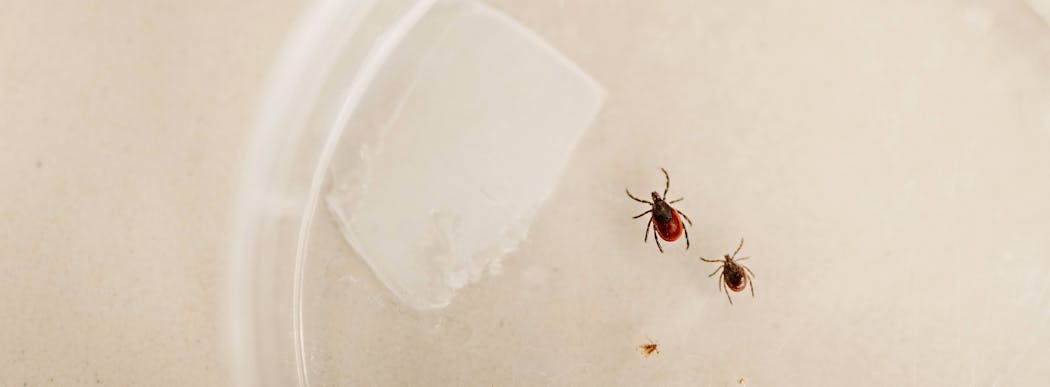Every year, deer ticks bite thousands of people in the Northeast, and as winters in the region become more mild, adult deer ticks are becoming more active at a time when they're normally dormant, causing a bigger public health risk.
"It's becoming a year-round, check-yourself-for-ticks situation," said Toni Lyn Morelli with the Northeast Climate Adaptation Science Center.
Morelli said if temperatures are at or above 40 degrees Fahrenheit, adult deer ticks will emerge to seek hosts in the winter.
Data from the U.S. Global Change Research Program shows that New England temperatures are rising faster than national and international averages. The largest increases in the region are happening during winter.
Deer ticks, also known as blacklegged ticks, can pass on Lyme disease, anaplasmosis and other sicknesses. Lyme in particular can cause chronic symptoms for some people.
"Everybody's looking for the scapegoat when it comes to vector-borne diseases and ticks and tick-borne diseases," said Megan Linske with the Connecticut Agricultural Experiment Station. "I think climate change is a big one."
According to the Minnesota Department of Health (MDH), bites from tick nymphs account for the greatest number of Lyme cases. This immature stage is active primarily between May and July, when about 20% of nymphs carry the bacteria that can cause the disease. The heat and dryness of summer tamp down their threat until ticks pick up again in the fall and are active until snow falls. Because of their size, roughly that of a poppy seed, these nymph bites tend to go unnoticed and represent the greatest number of Lyme cases. Adult ticks, about the size of a sesame seed, also bite people and can carry the bacteria that can cause the disease throughout much of the year. Some 40% of them carry Lyme.
Snowy weather changes the dynamic in Minnesota, said Elizabeth Schiffman, epidemiologist supervisor in the vector-borne diseases unit at the MDH.
Ticks are kept at bay under the snow, Schiffman said, but she noted Minnesota's trend toward variable weather. A March with less snow and an early thaw can extend tick season.
"Those ticks are going to be out," she said. "We have the possibility for an extended season but we just can't say which end of the season. It could depend on the year."
The epidemiologist said COVID-19 curtailed the department's deeper tracking of tick populations around the state, but there is good evidence that populations are expanding north and west in Minnesota.
The number of Lyme disease cases reported in Minnesota has been increasing yearly, according to MDH data. The median number of cases from 2010-2018 is 1,203; from 2000-2009, it's 915.
In New England, there is little active tick surveillance in winter, which requires going outdoors to collect ticks.
Instead, the Connecticut Agricultural Experiment Station runs a passive tick surveillance program to determine whether a tick bite gave someone a disease. Connecticut residents either drop off ticks they pulled off people or a pet, or mail them into the lab in New Haven, Conn.
On a day in February, Entomology Department head Goudarz Molaei tested a female adult deer tick that was sent in. It was so swollen that it was almost unrecognizable. The tick might have fed for several days, Molaei said, which could make it more likely to transmit an infection.
And his lab is seeing lots and lots of ticks.
From December into late February, he said 275 tick samples arrived at his lab, which is far more than past winters. Noelle Khalil, a research technician with the lab, placed the tick in a vial, added liquids, and shook it all up before putting it into a centrifuge.
"It's going to spin all this debris you see to the bottom," Khalil said, holding up the small mixture.
Results take a few days to come back after more steps and a PCR test.
Data from the Centers for Disease Control and Prevention shows that national Lyme disease rates have been steadily increasing, with New England experiencing the biggest increase in cases and overall infections.
Meanwhile, Northeast Regional Climate Center data shows that average regional temperatures from November to January were 1 to 7 degrees higher than normal for half of the last decade.
Linske, with the Connecticut Agricultural Experiment Station, said continued warming could lead to greater populations of native and non-native ticks.
Chantal Foster is an avid hiker from central Connecticut and no stranger to ticks. Her dog has had Lyme disease before and recovered, but Foster hasn't had it. Just this February, she said she picked ticks off her dog after two hikes. Foster is careful that she and her dog don't get bitten. "I'm not going to not go outside."
In 2019, Linske co-authored a study examining winter deer tick survival in coastal New England. One finding was that as the mean temperature increased, so did nymphal tick survival.
She said that people in the Northeast must learn to coexist with them year-round. Whether it's the backyard or the woods, the CDC advises avoiding brushy, wooded areas, tall grass and leaf litter, and doing a full body check of people and pets afterward.
Staff writer Bob Timmons contributed to this report.

This St. Paul native now goes by Kandi Krush, and she body-slams her opponents in the ring
Man agrees to 6-year sentence for fatally shooting Hopkins man on edge of downtown Minneapolis



